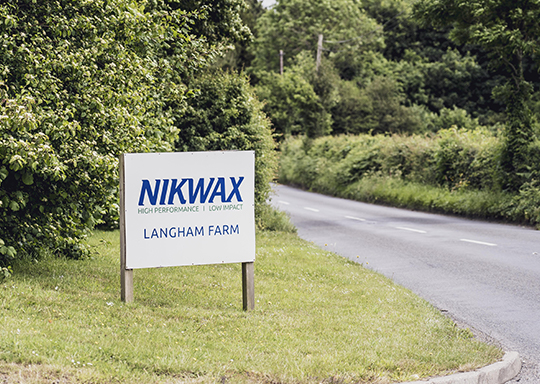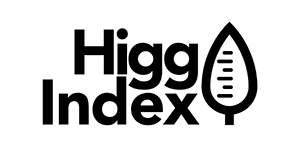
Measuring your environmental footprint is the essential first step if you’re aiming to reduce it. Without measuring your impact, it’s impossible to know if the polices you have put in place are working. Or, if not, whether to try a different approach. Nikwax now has several years of data, which helps us monitor how our performance has changed over time.
We realise that by publically sharing this data online, we open ourselves up to scrutiny. But we do this with the aim that this transparency will act as inspiration for our colleagues and suppliers and a catalyst to stimulate a of a continuum of new ideas and ways to innovate to reduce our impact further any way we can.
It’s one thing to have an internal point of view on how well we’re doing to be as sustainable as possible. But it’s another thing to bench mark yourself against the rest of the industry. Opening yourself up to comparisons with other companies can be risky for your reputation. But it is essential if you’re serious about being truly sustainable. You need to know how you well you’re really doing in the context of initiatives other companies are striving at to be better. Then question if you’re doing enough.

The Higg Index was developed by the Sustainable Apparel Coalition (‘SAC’ as it’s sometimes referred to). It is a suite of tools brands and retailers can use to measure every step of their sustainability journey. It accurately measures and benchmarks a company or product’s sustainability performance.
More information on the Higg IndexBeginning in 2018, Nikwax started to conduct Higg Index assessments once a year. These assessments are externally verified by a SAC-approved on-site assessor. By undertaking Higg assessments, we can gain an essential picture of how well Nikwax’s sustainability efforts stack up when measured against our peers.
Nikwax is scored on the effective environmental management of the following areas:
The graph below shows our performance over time. It’s worth being aware that the statistics here can’t be compared directly to other companies if they have not used exactly the same methods to measure their own performance.
It’s also important to be aware that there are potential differences between how different companies handle their operations. For example, where energy is concerned we can only measure our own usage and not that of our suppliers or service providers. Other companies might outsource their energy supply or printing. Click below to view the graphs
About this Graph
This graph shows our primary carbon dioxide emissions resulting from the use of gas, electricity, fuel for company vehicles and staff air travel. It does not include carbon emissions associated with third party suppliers and service providers.
We now purchase certified renewable energy for a significant amount of our electrical usage. We apply a Zero rating for carbon emissions from our certified renewable energy for the purposes of carbon offsetting.
Methodology Overview
The Environmental Management team gather data from across the company on the consumption of gas, electricity, petrol, diesel and air travel. They then use the standard conversion factors supplied by the UK Department for the Environment, Food and Agriculture (DEFRA), to convert these different energy sources into a CO2 equivalent. The conversion factors we use can be found on the DEFRA webpage.
These figures include the primary CO2 emissions associated with running our own operations. It is important to recognise that there are additional emissions associated with third party suppliers and service providers which cannot be included in our own reporting. For example, a proportion of our courier service's CO2 emissions are generated as a result of activities carried out for Nikwax, but data on exactly what proportion is not available.
If you have any questions regarding the methodology used to produce this graph, please contact the Nikwax Environmental Management team.
About this Graph
This graph shows how much gas and electricity we are using for offices and manufacture at our UK sites, relative to the amount of product that we make. The blue line is the monthly figure, which varies greatly throughout the year according to the seasons. The green line is a twelve month moving average which gives us a better indication of the overall trend. We're aiming for a downwards trend, which would indicate that we're becoming more efficient with time.
We use this benchmarked statistic rather than total consumption, because it allows us to judge the efficiency of energy use independently of the company's growth. Total consumption is not very useful for efficiency because it rises and falls according to how much we sell. What we want to ensure is that we are using energy as efficiently as possible, whatever the sales.
The statistic is not perfect however, and changes over time can be caused by factors other than efficiency. For example, if we were to outsource our bottle filling process, the energy used to run that line would no longer be accounted for internally, and would make the overall process appear more efficient. When there are significant changes in the graph, we will endeavour to insert a comment which explains the possible reasons, including whether there has been a change in outsourcing.
Our total consumption of energy, including transport, is used to work out our carbon dioxide emissions which we then offset by funding reforestation through the World Land Trust. This data is displayed in a separate graph.
Methodology Overview
Every month, readings are taken from all the electricity and gas meters at our UK sites. The energy use shown here is a result of manufacturing, heating buildings, powering computers, lighting etc. At the time of writing the statistic does not show energy consumption at our offices in the USA or Poland, but this is expected to be modest given their small size. Some of the buildings included in this measure are also shared by our sister company Páramo. Any buildings used exclusively by Páramo staff have been excluded.
Our manufacturing teams give a monthly report of the number of litres of finished product made. This includes all products lines. We then divide the monthly figure for energy use by the litres finished to generate the data points displayed above.
If you have any questions regarding the methodology used to produce this graph, please contact the Nikwax Environmental Management team.
About this Graph
This graph shows how much water we are using at our UK sites, relative to the amount of product that we make. The blue line is the monthly figure, which varies greatly throughout the year according to the seasons. The red line is a twelve month moving average which gives us a better indication of the overall trend. We're aiming for a downwards trend, which would indicate that we're becoming more efficient with time.
We use this benchmarked statistic rather than total consumption, because it allows us to judge the efficiency of water use independently of the company's growth. Total consumption is not very useful for efficiency because it rises and falls according to how much we sell. What we want to ensure is that we are using energy as efficiently as possible, whatever the sales.
The statistic is not perfect however, and changes over time can be caused by factors other than efficiency. For example, if we were to outsource our bottle filling process, the water used to flush out that line would no longer be accounted for internally, and would make the overall process appear more efficient. When there are significant changes in the graph, we will endeavour to insert a comment which explains the possible reasons, including whether there has been a change in outsourcing.
Methodology Overview
Every month, readings are taken from all the water meters at our UK sites. The water use shown here is a result of manufacturing, bottle filling, toilets and drinking water etc. At the time of writing the statistic does not include water consumption at our offices in the USA or Poland, but this is expected to be modest given their small size. Some of the buildings included in this measure are also shared by our sister company Páramo. Any buildings used exclusively by Páramo staff have been excluded.
Our manufacturing teams give a monthly report of the number of litres of finished product made. This includes all products lines. We divide the monthly figure for water use by the litres finished, to generate the data points displayed above.
If you have any questions regarding the methodology used to produce this graph, please contact the Nikwax Environmental Management team.
About this Graph
This graph shows the percentage of waste from our UK sites which we are sending to landfill, against the percentage of waste sent for recycling. When we refer to waste, we mean any solid material that leaves our site which is not product, packaging or marketing material.
Over the years, we have been steadily increasing the number of recycling streams to include cardboard, soft and hard plastics, paper, glass, metals, batteries and light bulbs, amongst others.
We had originally set ourselves a goal that by the end of 2017 we would be recycling 100% of our site waste and sending none of this to landfill. This was an ambitious target and, although we have made significant progress, we are not there yet. However, our commitment to send zero waste to landfill remains so we are extending this target to 2020 and are investigating a number of other options to ensure we achieve it.
Methodology Overview
The Environmental Management team gather waste data from across the company. Each site has a number of different bins which are emptied at various frequencies. Bin weights are measured wherever possible, however in some cases we have to use our waste companies’ estimated weights, based on bin size.
Once all weights have been totalled we then look at the combined recycled weight and the combined landfill weight, and calculate the percentages of these against the total waste produced. This statistic is calculated annually at the end of our financial year.
